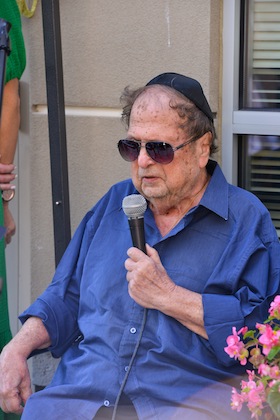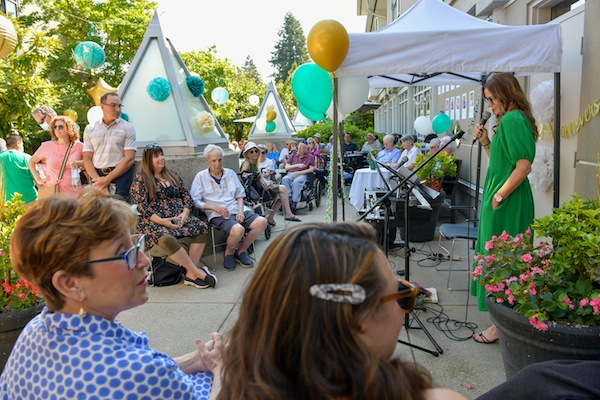Vanessa Trester, manager of the Weinberg Residence, speaks to those gathered at the 20th anniversary party. (photos by Galit Lewinski)
The Weinberg Residence has just entered its 20th year. The assisted living and multi-level care facility opened in 2003 as the city’s first Jewish residence for people who choose the round-the-clock care and companionship they might not have at home. A celebration took place Aug. 21.

The Weinberg is located at the Dr. Irving and Phyliss Snider Campus for Jewish Seniors, which is also the location of the Louis Brier Home and Hospital. While the residents and staff are celebrating this anniversary milestone, plans are afoot for big changes in the years to come.
The Weinberg, which is a private, but not-for-profit, facility, opened at a time when the idea of assisted living was relatively fresh. The concept is a step between fully independent housing and supportive living – residents are able to live independently but sometimes need or desire a little assistance with things like personal care, and they enjoy the liberty of not having to cook.
The Weinberg includes a kosher dining room and special meals for Jewish holidays, as well as private dining for family events. There is 24-hour staffing, as well as a range of cultural, therapeutic and recreational activities. The Chava and Abrasha Wosk Synagogue is located on the campus, with regular and holiday services available without having to leave the premises.
The multi-level nature of the facility means it can welcome people across a large span of ages and physical needs.
“What’s really unique about the 24-hour care unit is the different residency options that historically we’ve offered within the unit,” said Vanessa Trester, manager of the Weinberg Residence. In addition to the assisted living option, there is the possibility of convalescence periods, post-surgery recovery, shorter stays, including for out-of-town guests who need support, as well as palliative support.

Trends in senior living have had an impact on the Weinberg, as they have had on all such facilities. Health authorities are encouraging aging in place, with governments funding more services to keep people at home longer and out of institutional care. As a result, said Trester, residents tend to be coming to the Weinberg at a later age than they might have in times past.
“It just means people are coming later in life,” she said. People who come in their 90s, rather than their 70s or 80s, will most likely have higher needs and require additional services upon first arrival.
“We see more people who are requiring 24-hour care,” said Trester. “The longer people wait, the more their needs increase.”
The residence was built by the Jewish community, Trester stresses, who raised $11 million to make it a reality.
“We are the Jewish campus,” she said. “So there should be a lot of pride and contentment from the community.”
However, like so many other institutions in Vancouver’s Jewish community, the Weinberg and the entire Snider campus are facing dramatic changes.
The campus is located kitty-corner to the Jewish Community Centre of Greater Vancouver, whose $450 million redevelopment plan, called JWest, represents the most ambitious construction project in the history of Jewish Vancouver. Originally considered as part of that project, the 4.3-acre Snider Campus site will be revamped independently.
“There are tentative plans in place for Louis Brier redevelopment,” said Dr. David Keselman, chief executive officer of the Louis Brier Home and Hospital and Weinberg Residence. “There are assumptions of what it should be, can be and may be. It all really depends on approvals from the City of Vancouver, funding from Vancouver Coastal Health, all this kind of stuff.”
Management is in the due diligence stage, Keselman said. But even though the Weinberg Residence is far newer than the Louis Brier Home that shares the campus, both institutions are almost certain to be replaced in the future.
“The new build, of course, will be looking at going up versus horizontal,” Keselman said. “It depends on what the decisions are going to be, and approvals we get in the end, how big that building is going to be and how many beds it’s going to end up being.”
The Brier began as a seven-room seniors facility 70 years ago. It has transformed, grown and moved over the decades – and time marches on.
Timing of the redevelopment also depends on how fast approvals can be obtained, plans are finalized, costs are determined and funds are raised. “I’m going to say anywhere between eight to 12 years,” Keselman said.

